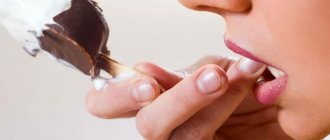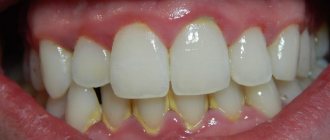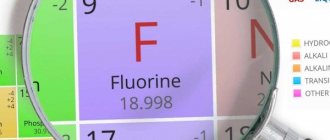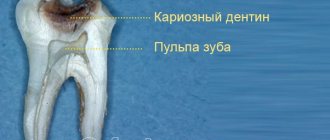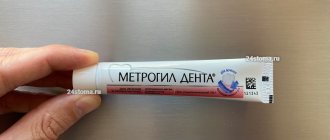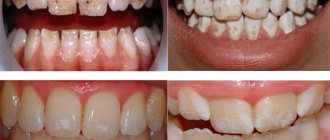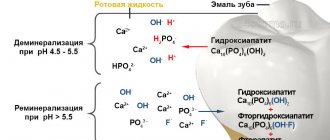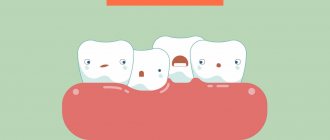Food debris, accumulations of bacteria and saliva form a film that tightly adheres to the enamel, tongue, gum edge and even orthodontic structures. This film is plaque and is called dental plaque. It is impossible to prevent its formation. Within a few minutes after cleaning, plaque begins to form again. In the absence of daily hygiene, the film gradually hardens with the formation of tartar. But even proper regular brushing of teeth does not always prevent the appearance of deposits.
Dentists at the Nurimed clinic will conduct a professional examination of the oral cavity, determine the causes of plaque formation and help get rid of it using innovative technologies and modern equipment. You can make an appointment by phone or by using the feedback form.
Causes of plaque on teeth
The main risk factors for deposit formation are:
- Lack of oral hygiene;
- Incorrect selection of cleaning products;
- Excessive consumption of simple carbohydrates (sweets, baked goods, carbonated drinks, sugar, etc.);
- Predominance of soft foods in the diet, lack of hard foods;
- Drinking coloring drinks, including coffee and tea;
- The presence of fillings, dentures, braces and other orthodontic structures;
- Chips, cracks and other damage to the dentofacial apparatus;
- Smoking;
- Individual properties of saliva;
- Intensity of chewing food;
- Diseases of the gastrointestinal tract;
- Diseases with metabolic disorders;
- Congenital and acquired defects or anomalies of the dentofacial apparatus;
- Long-term treatment with antibacterial drugs.
Another reason why plaque appears can be improper brushing of teeth. Oral hygiene should include not only the front surface of the teeth, but also the back, as well as the tongue. Hard-to-reach spaces can be cleaned using thread.
Diagnostic features
If supragingival stones are easy to see on your own, then those located under the gum can only be seen with the help of special tools from a dentist. Diagnosis is carried out as follows: the doctor immerses the probe into the periodontal pocket, which makes it possible to verify the presence of hard deposits, as well as determine the depth of the pocket. This will allow you to choose how to remove the stones.
It is possible to diagnose supragingival calculus even in the early stages of its appearance. There are special tablets on sale that, when bitten, stain areas of the tooth with stone.
How is plaque formed?
First, soft plaque forms on the teeth, the formation of which consists of three stages:
- A couple of minutes after the end of cleaning the oral cavity, active reproduction and spread of bacteria throughout the oral cavity begins. The process takes 4 hours, after which the number of bacteria reaches a million.
- Over the next 3 hours, the bacteria attach to the surface of the tooth enamel and form a soft film. After fixation, microorganisms begin to release substances that destroy the enamel, causing carious lesions to develop.
- When 8 hours have passed after cleansing the oral cavity, deposits become visible and structured. The majority of bacteria in them do not require oxygen.
The resulting film progressively thickens and becomes denser. hard plaque forms within a day after the last brushing. The formation of tartar is typical for surfaces that have little contact with the tongue and food.
What kind of raid is there?
Dark enamel
The main risk factors for the formation of dark-colored deposits:
- Dysbacteriosis in childhood;
- Hypoplasia of teeth, often of a congenital nature, in children;
- Smoking, consumption of coloring products;
- Deficiency of salivation;
- Disorders of calcium, vitamin D, and phosphorus metabolism.
There is no way to get rid of this problem at home. Increasing the intensity of cleaning will only worsen the situation. It is necessary to eliminate the original cause. Adults are often offered cosmetic correction with veneers.
Black plaque on teeth
The formation of black deposits in childhood is caused by problems with the digestive system, helminthic infestations or fungal infection of the oral cavity.
In adults, risk factors are:
- Alcohol abuse, smoking, drug addiction;
- Long-term (more than 2 weeks) use of antibacterial agents;
- Severe somatic pathologies (decompensated liver disease, dysfunction of the spleen, and so on);
- Change in pH in the mouth;
- Working with metals (harmful working conditions);
- Copper products in the oral cavity;
- Diseases of the endocrine system;
- Allergies;
- Parasitic infections;
- Chemotherapy treatment.
The black tint cannot be removed with special whitening pastes, so instead of wasting money, it is better to immediately contact Nurimed dentists.
Yellow film
Normal enamel has different shades of yellow. The natural yellowness of the teeth is inherited. In addition, an excess of various minerals in the diet is also a common cause of yellowing of the enamel.
Causes of yellow plaque on teeth near the gums:
- Bad habits, consumption of coloring products;
- Excess of sweets in the diet;
- Frequent changes in diet and diet;
- Mechanical damage to the dentofacial apparatus;
- Lack of personal hygiene;
- Wearing braces without proper care;
- Age-related changes in enamel color.
At the initial stages, you can deal with yellow deposits on your own. However, it is recommended to consult a dentist to ensure that cleansing does not damage the enamel.
White deposits
White plaque on teeth is most common. These deposits form on tooth enamel every day and must be brushed off with a toothbrush. Otherwise, the film hardens with the formation of tartar.
Additional risk factors:
- Hypovitaminosis;
- Poor nutrition;
- Lack of solid foods (especially in children);
- Improper cleaning of the mouth.
If daily care does not help completely get rid of the white film, consult your dentist. The doctor will determine the optimal cleansing algorithm and give recommendations.
Brown plaque on teeth
It often develops in smokers, coffee and black tea drinkers. Additional reasons for education:
- Rinse mouth with manganese solution;
- Impact of iodine, chlorine on enamel;
- Ingestion of vapors of mercury, iron, manganese, nickel, lead;
- Rh conflict during pregnancy (destruction of red blood cells).
Fixing the problem on your own is almost impossible. An important stage of the fight is identifying the cause followed by treatment.
Coffee stains on teeth
Drinking coffee leads to the formation of a persistent dark film on the enamel. Without special cleaning methods, deposits cannot be removed.
The following measures will help reduce the intensity of color changes:
- Reducing the amount of coffee you drink;
- Increasing the amount of vegetables and fruits in the diet;
- Use of whitening pastes;
- Use of rinses.
Regular professional teeth cleaning will help keep your teeth beautiful and healthy.
Smoker's plaque
Plaque on teeth from smoking is a specific discoloration of the enamel that is difficult to get rid of. The following signs help to distinguish it from deposits of other origin:
- Soft tissues of the mouth without signs of inflammation;
- Darkening of the enamel begins from the cervical area;
- The presence of a putrid odor;
- Gums are pale pink.
Ignoring the deposition of resins in the oral cavity leads to the development of inflammatory processes and persistent bad breath.
Possible complications
Plaque is the #1 cause of gum inflammation (gingivitis and periodontitis). Therefore, in the long term, this problem can even lead to tooth loss. In addition, deposits are localized on the teeth, and the bacteria that make them up lead to the destruction of enamel, the appearance of caries and other dental diseases.
The aesthetics of a smile are also disturbed, an unpleasant and even putrid odor from the mouth occurs, which affects a person’s psychological comfort. Another consequence is disruption of the digestive tract, since plaque is bacteria and, along with food, they also enter the stomach.
How to get rid of plaque on teeth?
If you notice a change in the color of the tooth surface, it is recommended to consult a dentist to combat it. The doctor will be able to accurately determine its cause, then carry out professional cleaning with minimal risk of complications. However, in the initial stages, plaque removal on teeth can be done at home if you follow practice-tested recommendations.
How to remove plaque at home?
Deposits, regardless of the cause of their appearance, cause aesthetic discomfort. Before turning the soft film into hard stone, you can try to get rid of it at home. The following methods are used to treat dental plaque at home
- Using an irrigator. The device helps thoroughly remove food debris and thin film using a directed stream of water. The irrigator helps to clean even places that are difficult to reach with a toothbrush, such as the spaces between the teeth.
- Baking soda. The technique is suitable for one-time use, since soda with frequent use has a negative effect on the condition of the enamel. To clean, you need to dilute the baking soda with a small amount of water to form a paste, and then gently brush your teeth with it.
- A solution of salt and soda. The product is used as a mouth rinse before regular brushing with regular toothpaste. To do this, a small amount of soda and water is diluted in warm boiled water.
- Hydrogen peroxide. The product is also suitable for one-time use. Peroxide 3% is added to water, and then the surface of the enamel is wiped with a cotton pad soaked in it.
Not all types of deposits can be cleaned at home, so it is recommended to contact a professional dental clinic.
Professional removal
Contacting dentistry is the best solution for the formation of plaque and tartar. The Nurimed Clinic offers modern methods to eliminate the problem, which have a gentle effect on the enamel, but effectively remove deposits. In modern dentistry, the following methods of combating plaque are used:
Using a laser. This is a relatively recent technology that is highly effective and has no contraindications. The price of this technique corresponds to the results obtained. Laser technology allows not only to effectively remove deposits without causing negative effects, but also to successfully get rid of pathogenic microorganisms.
Ultrasound technique. An ultrasound machine is used to direct waves to dental plaque. The deposits are peeled off and the enamel becomes smoother. The latter factor prevents bacteria from firmly attaching, so the cleaning effect lasts longer.
Air abrasive technology. Special equipment is used that directs microparticles of a special powder onto the teeth to soften plaque, water and air. Plaque is effectively peeled off from the enamel.
Isolated removal of deposits without identifying the cause of their active formation will not eliminate the problem. If the enamel darkens due to external factors, additional lightening techniques must be used. For example, removing dark plaque from cigarettes on teeth is a rather complicated procedure, the effect of which will not last long if you continue to smoke.
Contacting qualified dentists at the Nurimed clinic guarantees a comprehensive approach to the problem of changes in enamel color and the formation of deposits.
Prevention
The formation of deposits on enamel is a physiological process that cannot be eliminated completely. However, there are general rules to reduce the intensity of its formation and minimize pathological consequences. These include:
- Personal hygiene. You should brush your teeth at least twice every day. In this case, you need to follow the cleaning rules recommended by dentists in order to get rid of the maximum amount of food debris and bacteria.
- Correct selection of paste and brush. Choosing the right teeth cleaning tools matters more than many people think. The brush should not injure the gums. It needs to be changed every 3 months. The paste is selected according to age.
- Using dental floss and mouthwash. Dental floss allows you to get rid of food debris and deposits in the spaces between the teeth. The rinse has a beneficial effect on the condition of the enamel and promotes the normal functioning of the gums. It can be used after meals to reduce the amount of bacteria in the mouth.
- Timely treatment. Diseases of the oral cavity, gastrointestinal tract, and other systems must be treated promptly and correctly. Self-medication can only aggravate the situation and lead to complications.
- Proper care. Orthodontic structures in the oral cavity require separate cleaning and care. Ignoring this factor not only leads to increased formation of deposits, but can also cause the development of an inflammatory process.
- To give up smoking. A bad habit negatively affects the entire body.
- Avoiding excessive consumption of coffee, tea, and coloring drinks.
Every person should have their teeth professionally cleaned once a year to remove tartar and hard deposits on the enamel. This allows you not only to improve the appearance of your teeth, but also to prevent a number of oral diseases. The reason why you should contact Nurimed is an individual approach to each client’s problem followed by a comprehensive solution.
Kinds
There are two types of tartar, depending on its location - subgingival and supragingival.
Subgingival tartar can only be detected by a dentist using a special probe, since it is hidden from view by the edge of the gum. It is located in the periodontal pocket and fits tightly to the root. The color of this stone is usually dark brown or greenish-black, it is extremely hard and consists mainly of calcium phosphate, magnesium phosphate and calcium carbonate. If subgingival stone is not removed in a timely manner, it can provoke an inflammatory process in the periodontium and cause periodontitis.
Supragingival tartar can be diagnosed independently; it stands out on the surface of the enamel with its yellowish or brownish color and is easily removed using a dental excavator. It is usually located above the crest of the gingival margin, so it is easy to recognize. In terms of density, supragingival stone is much softer than subgingival stone, since it is a salivary type formation and consists mainly of epithelial cells, bacteria, mucus and food debris. If it is not removed in a timely manner, over time the hardened plaque turns into caries.
